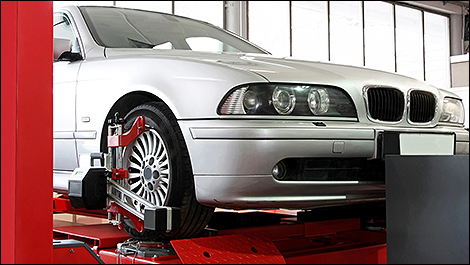Apr
10th
Stay connected Subscribe to our RSS feed
As the only part of your vehicle that touches the ground, your wheels must be perfectly aligned to ensure optimum safety on the road, not to mention reduced tire wear and improved fuel economy. Hitting big potholes and bumps is a major cause of improper wheel alignment.
When driving in a straight line, let go of the steering wheel to check how the vehicle reacts. Odd steering behaviour (including vibrations and a steering wheel that seems to have a mind of its own) is a definite sign that your front wheels need an inspection and possibly a realignment. Uneven tread wear is often a good indicator, as well.
By definition, “wheel alignment” involves three main measurements: toe, camber, and caster.
Toe
Camber
Caster
Geometry
When driving in a straight line, let go of the steering wheel to check how the vehicle reacts. Odd steering behaviour (including vibrations and a steering wheel that seems to have a mind of its own) is a definite sign that your front wheels need an inspection and possibly a realignment. Uneven tread wear is often a good indicator, as well.
By definition, “wheel alignment” involves three main measurements: toe, camber, and caster.
Toe
- Toe is a measurement of how much the front and/or rear wheels are turned in or out when sitting in a straight-ahead position. When the wheels turn in, toe is positive. When the wheels turn out, toe is negative. The purpose of toe is to ensure that the wheels roll parallel.
- Improper toe adjustment results in premature tread wear and causes steering instability (lateral pull) when accelerating or braking. After a while, it can also damage a suspension's pivot points.
- Each car has precise toe specifications (determined by the manufacturer) for optimum wheel alignment. In order to correct toe, a mechanic will adjust the rack-and-pinion steering's inner tie rod up front, and either a specific control link or cam system in the back.
Camber
- Camber is the tilting of the wheels from the vertical axis when viewed from the front. If the wheel tilts outward at the top, camber is positive. If the bottom of the wheel is farther out than the top, camber is negative.
- The camber angle defines the handling dynamics of a particular suspension design; more specifically, negative camber improves grip when cornering. Unequal side-to-side camber of 1 degree or more will cause the vehicle to pull or lean to the side with the most positive camber. Meanwhile, the tires will wear unevenly.
- Front and rear camber can be adjusted via a control arm or cam system, but only on cars with a double-wishbone suspension (it is always fixed with MacPherson struts).
Caster
- Caster is the tilting of the uppermost point of the steering axis either forward or backward (when viewed from the side of the vehicle). A backward tilt is positive, and a forward tilt is negative. Altering the caster angle changes the vehicle's wheelbase and ride height.
- When a front suspension is aligned, caster is adjusted to achieve the self-centring action of steering, which affects the car's straight-line stability. If the steering wheel takes longer to return to its on-centre position, there's a problem.
- Once again, front and rear caster can be adjusted via a control arm or cam system.
Geometry
- Problems also arise when the front wheels (or axle) are not aligned with the rear wheels (or axle), causing the vehicle to wander to one particular side. This is often referred to as improper geometry.
- In all cases, repair shops use camera-based systems on each wheel to monitor their action and provide data to a computer to properly align the wheels and settings.
 |
 The latest auto news, reviews, prices, product and vehicle releases.
The latest auto news, reviews, prices, product and vehicle releases.